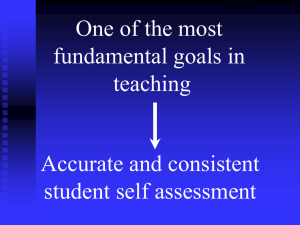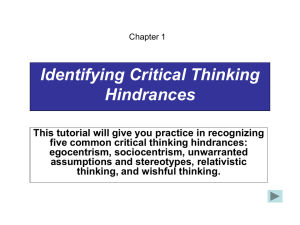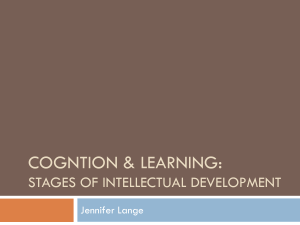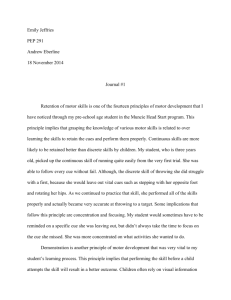Lecture 1 - Critical Thinking
advertisement
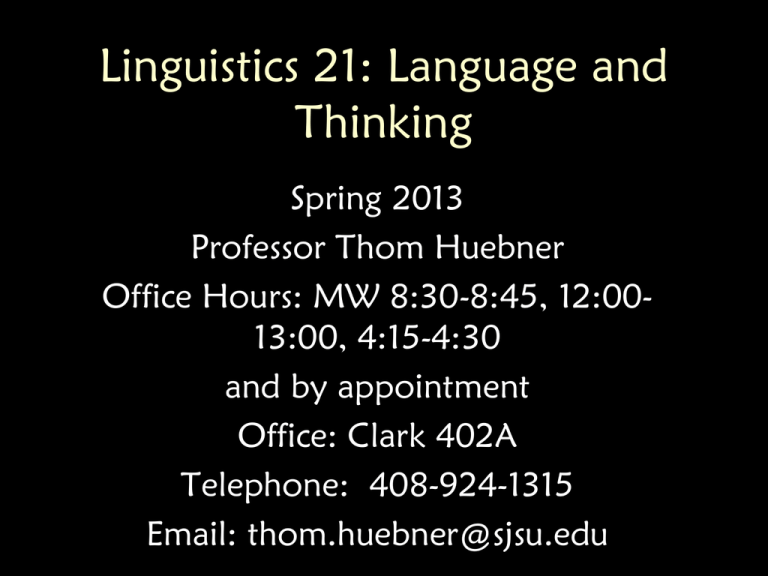
Linguistics 21: Language and Thinking Spring 2013 Professor Thom Huebner Office Hours: MW 8:30-8:45, 12:0013:00, 4:15-4:30 and by appointment Office: Clark 402A Telephone: 408-924-1315 Email: thom.huebner@sjsu.edu Lecture 1: Critical Thinking – What is it? When you hear the term ‘critical thinking,’ what does that mean to you? CRITICAL THINKING Involving or exercising skilled judgment or observation Wide range of cognitive skills and intellectual dispositions needed to – analyze and evaluate arguments and truth claims: Examples: Slide 4 overcome personal prejudices and biases: Example: language accents make reasonable and intelligent decisions about what to believe and what to do. INTELLIGENT DECISIONS Critical Thinking - What are the characteristics of a critical thinker? - What is an argument? - Why is critical thinking important in the world today? STANDARDS 1. 2. 3. 4. 5. 6. 7. 8. Clarity Accuracy Precision Relevance (Focus) Consistency Logical correctness Completeness (Depth) Fairness CLARITY Example: Miss Teen South Carolina http://www.youtube.com/watch?v=lj3iNxZ8Dww Questions: – Which of the standards of critical thinking does Miss TSC not meet? Why? – Can you think of other examples of people “not being clear on the concept”? Relevance, Focus http://www.youtube.com/watch?v=qvzim5rC eFw&feature=fvw Is ex-Governor Palin’s answer to the question relevant? Why or why not? CONSISTENCY Logical consistency: Not saying or believing two (or more) things that could not simultaneously be true – Example: P & ~P Practical consistency: Not saying one thing and doing another – Example: Calvin and Hobbs, P. 12 Exercise: Generate examples of logical / practical inconsistency: page 7, Exercise 1.1 II. LOGICAL CORRECTNESS All mammals are dangerous. Bobo is dangerous. Therefore Bobo is a mammal. I am a man. Brad Pitt is a man. Therefore, I am Brad Pitt. All humans are animals. Most animals can climb trees. Therefore, most humans can climb trees. FAIRNESS Not identifying truth with self-interest Not resisting unfamiliar ideas, prejudging issues, stereotyping outsiders BARRIERS 1. 2. 3. 4. 5. Egocentrism Sociocentrism Unwarranted assumptions and stereotypes Relativistic thinking Wishful thinking EGOCENTRISM Egocentrism: Seeing reality as centered on oneself Self-interested thinking: Accepting and defending beliefs that harmonize with one’s own self-interest – Example: “A rising tide raises all boats.” Self-serving bias: Overrating oneself – Example: 90% of drivers rate themselves as above average SOCIOCENTRISM Sociocentrism: Group-centered thinking Group bias: Seeing One’s own group, tribe, sect, sex as better – Example: “Girls are better than boys.” Conformism: Following the crowd, conforming uncritically to group standards of conduct and belief – Example: The lines experiment: page 16. RELATIVISTIC THINKING Relativism: “There is no objective absolute standard of truth.” Subjectivism: “Truth is a matter of individual opinion.” Exercise: List areas where truth may be a matter of opinion. Cultural relativism: “What is true for person A is what person A’s culture of society believes is true.” Examples: drinking wine in France/Iran; polygamy MORAL RELATIVISM Moral subjectivism: What is morally right and good for an individual A is what A believes is morally right and good. – Example: Premarital sex – – Premarital sex is always wrong. – Premarital sex is not always wrong PROBLEMS Relativism makes it impossible to criticize others’ / our own cultural practices, i.e., cannibalism / racism It rules out the idea of moral progress, i.e., meaning of equality It can lead to conflicting moral duties: – When an individual holds beliefs in conflict with those of her society; – When an individual belongs to two or more cultures. Discussion: Are you bi-cultural in any sense (do you belong to two or more groups that hold conflicting beliefs on a topic)? UNWARRANTED ASSUMPTIONS Assumption: Something we take for granted, something we believe to be true without any proof or conclusive evidence We have to make assumptions (the floor was there yesterday when I got out of bed; it’ll be there today). This only becomes pernicious when those assumptions are unwarranted. Stereotypes are unwarranted assumptions. Error: Hasty generalization – making a generalization about a large class of people from a small sample Discussion: Identify assumptions you’ve made since you got up this morning. Were they warranted? WISHFUL THINKING Wishful thinking: believing something not because you have good evidence for it, but because you wish it were true. Examples: “The wind will pick up.” “He loves me.” “I don’t have a 1-73 chance of dying in a car accident.” Exercise: Generate examples of hindrances to critical thinking. CHARACTERISTICS of a Critical Thinker Passionate drive for clarity, precision, and accuracy Careful, disciplined thinking Sensitivity to the ways that critical thinking can be prejudiced by egocentrism, wishful thinking and other psychological barriers Honesty and intellectual humility Open-mindedness, intellectual courage, love of truth, intellectual perseverance Short ‘Think Piece” Review the list of critical thinking traits, p. 25-26: – – – – – – – – – – Clarity, precision, accuracy Sensitivity to egocentrism, sociocentrism, wishful thinking Intellectual honesty Open-mindedness Fact-based beliefs Awareness of biases and preconceptions Independent thinking Intellectual courage to face ideas fairly Pursuit of truth Intellectual perseverance Short ‘Think Piece” Jot down short responses to the following questions: – Which of the traits listed do you think is your strongest critical thinking trait? Why? – Which is your weakest? Why? – What could you do to improve in this latter regard?
